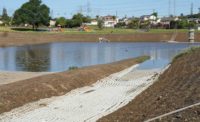Washington, Ind., didn't have the cash to upgrade five combined sewer overflows (CSO) discharging into Hawkins Creek, a frequent occurrence due to limited storage capacity and the age of the CSO collection system.

Even 1/10-in. rainfalls triggered untreated discharges, resulting in the accumulation of pollutants once discharge pooled and dried.
While a 2002 engineering study estimated it would cost $39.9 million—or roughly $7,500 per household—to properly capture and treat stormwater runoff, a 2009 study pushed costs higher, to $53 million.
Washington executed a more affordable alternative: It launched a $23.8-million project involving the capture of the CSO first flush in a 5-million-gallon storage tank—or less than the 1-year/1-hour storm event. From there, it is pumped to an existing wastewater treatment plant to receive conventional treatment.
During larger events, overflow from the tank—up to a 10-year/1-hour storm event—travels via a pair of 84-in. pumps to a 21-million-gallon, 27-acre constructed wetland for treatment. From there, effluent passes through a UV system before discharging into Hawkins Creek.
The 5-million-gallon storage tank is equipped with groundwater controls, allowing fluid to be pumped directly to the wetland or the creek. The controls also allow Washington to regulate the amount of water diverted to the UV system, effectively controlling the moisture content of the wetland.
Although state regulations required only the equivalent of primary clarification, followed by disinfection, for all flows above the 1-year/1-hour design, the constructed wetland meets secondary limits, providing a high degree of nitrogen reduction.
The installation also features a headworks for fine screening and coarse grit removal, a forebay pond for fine sediment removal, an under-drain system for dewatering and a recirculation system for draining the forebay pond and controlling wetland soil moisture.
The installation is said to be only the second of its kind in the U.S., and it is more than three times larger than the first.
Constructed Wetlands for Treatment of Combined Sewer OverflowsWashington, Ind. Key Players







Post a comment to this article
Report Abusive Comment